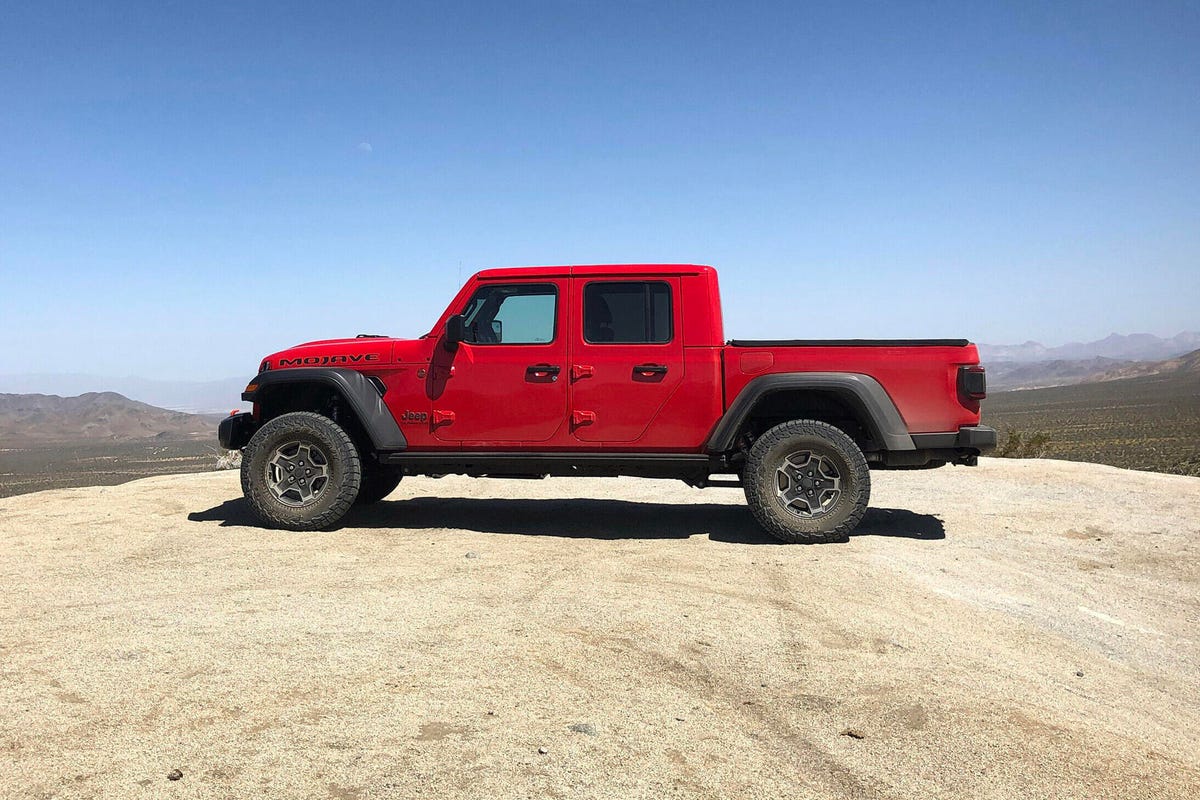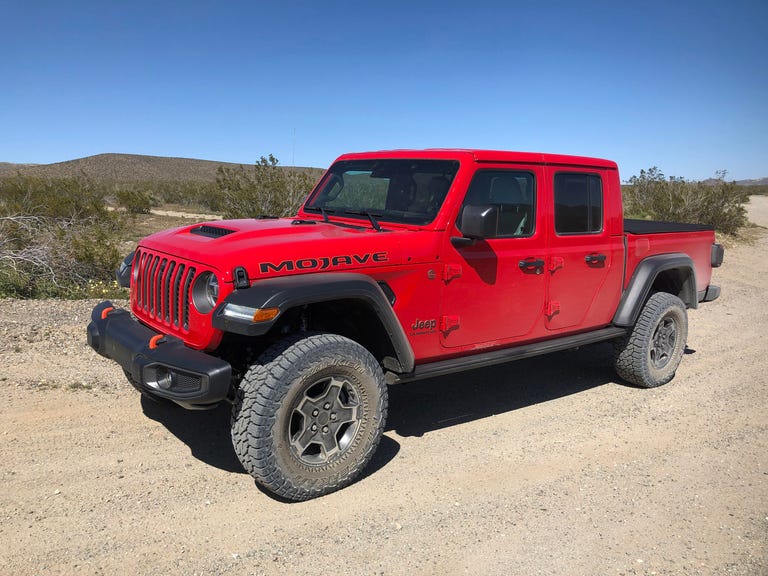 Why You Can Trust CNET
Why You Can Trust CNET 2020 Jeep Gladiator Mojave review: Desert runner
With its heavily revised suspension, this Jeep is built for off-road speed.

The king of the rocks is now the king of the desert.
When I first drove the Jeep Gladiator Rubicon, I thought I'd found my off-road dream truck. Solid axles, a crazy crawl ratio, front and rear differential lockers and a convertible to boot? Hell yes. But then Jeep unveiled the Gladiator Mojave, and now that I've had a chance to put it through its paces, well, move over, Rubicon.
Like
- Purposeful suspension upgrades
- No noticeable loss in other off-road abilities
- Easy-to-use Uconnect infotainment tech
- The roof comes off!
Don't like
- Reduced tow rating
- Fully loaded models get pretty expensive
The Mojave is only offered with four-wheel drive and a two-speed transfer case. It's also only available with Jeep's 3.6-liter V6 engine, and while a six-speed manual transmission is standard, you can opt for an eight-speed automatic for $2,000.
This is also the first vehicle to get Jeep's new Desert Rated badge. This means that, in addition to all of the usual off-road stuff that goes into earning the Trail Rated badge, the Gladiator Mojave is prepped for high-speed desert running. I'm talking about bombing through whoops and scrambling up dunes. Yes, any Gladiator can do things like this, but with its 1-inch front lift and completely retuned suspension, the Mojave will get through this kind of terrain easier and faster.
Both the front and rear suspension get revised Fox internal-bypass shocks with remote reservoirs. The front adds a Mojave-exclusive hydraulic Fox jounce shock for extra damping capability. Think of this as a shock within a shock, able to absorb extra-hard hits without compromising overall ride quality.
Out in the desert, the Mojave's suspension has no trouble handling the impacts from 1.5-foot-deep whoops, and more importantly, does so without losing stability. If I ran this same course in a Gladiator Rubicon, the front end would turn into a pogo stick.
The Gladiator Mojave gets Jeep's Off-Road Plus setting, which is also available on the Rubicon. Activating this in 4WD High, the Plus mode makes the throttle more responsive, switches up the shift points for the automatic transmission and reduces the intervention of the electronic stability control. Combined with the added jounce shocks, this makes the Mojave far more capable for higher-speed desert running.
Which brings me to power. With 285 horsepower and 260 pound-feet of torque from this naturally aspirated V6, the Mojave definitely isn't as quick as a Ford F-150 Raptor. On the other hand, I'm not really sure a Toyota Tacoma TRD Pro could keep up, what with its similarly powered V6 and less sophisticated suspension.
The Mojave's four-wheel-drive system is upgraded to handle higher off-road speeds, too. The Mojave gets Jeep's Command-Trac technology with a 2.72:1 low-range gear ratio, and while this means the Mojave won't have as much torque at slow speeds as the Rubicon, this allows it to be driven faster in its lowest off-road gear. This is a good thing: The Mojave is built more for the dunes and desert, where momentum is key, compared with the Rubicon, which is meant to handle rocks, where slow speed is required.
Despite this less aggressive gearing, the Mojave should still be more than capable of handling rocky trails, thanks to its excellent suspension geometry. The Mojave even has a better approach angle than the Rubicon thanks to its 1-inch front lift: 44.7 degrees compared with 43.4 degrees in the Rubi. The breakover angle is a tiny bit better, 20.9 degrees compared with 20.3 degrees. For the rear, the Rubicon wins here by a nose: 26 degrees compared with 25.5 degrees in the Mojave. The Mojave also has 11.6 inches of ground clearance, which is a skosh higher than the Rubicon.
Up front, there's a 1-inch lift compared with a Gladiator Rubicon, as well as a hydraulic Fox jounce shock for better damping.
When the going does get rocky, the Mojave has a 57.3:1 crawl ratio with the manual transmission, or 52.6:1 with the automatic. These numbers best competitors like the Chevrolet Colorado ZR2 and Toyota Tacoma TRD Pro by a long shot, but aren't quite as robust as the Gladiator Rubicon. What's more, the Mojave doesn't have a front diff locker, like the Rubicon does, but aside from the most extreme situations, I can't imagine the Mojave not having enough capability to get through 95% of your rock-crawling needs. Oh, and that aforementioned Off-Road Plus mode? Activate this when you're in 4WD Low and it actually does the reverse of its action in 4WD High, softening the throttle response and keeping the engine's power on tap for steady crawling.
I do have a couple of very minor off-road issues, however. The Mojave can't be had with the Rubicon's winch-ready, steel front bumper, so I'm left with the plastic bumper with its fake vents. Also, even though the Mojave comes with sand-slider side rails, and I can add the optional steel rock-slider rails, there's no protection for the truck's bed, and I know at some point the rear is going to smack something.
As for the Mojave's on-road manners, it drives like any other Gladiator. That is to say, it wanders a bit and the steering is pretty vague. The ride quality is really nice, though, especially for a truck with a solid-axle configuration. Where Jeeps were once relegated to the slow lane, toddling along at 60 mph because anything faster felt dangerous, the Gladiator's modern chassis and great suspension mean I can set the cruise control at 75 mph and relax. Yes, there's a lot of road noise from the 33-inch Falken Wildpeak tires, but considering their meaty tread, it's to be expected.
The interior carries over unchanged, complete with Jeep's Uconnect infotainment system on an 8.4-inch touchscreen.
Oh, and what about truck stuff? The Mojave's utility is right in the middle of the Gladiator lineup. Depending on trim level the Gladiator can haul anywhere from 1,105 to 1,700 pounds in the bed and has a towing range of 4,000 to 7,650 pounds. The Mojave can handle 1,200 pounds of payload and tow up to 6,000 pounds with the automatic transmission. Opt for the manual, though, and that drops to 4,500 pounds. If you want a Gladiator with maximum towing ability, get a Gladiator Sport with the max tow package.
Visually, the Mojave has a few visual cues that set it apart from other Gladiators. You'll notice the Desert Rated badging, obviously, as well as the giant "Mojave" text on the hood. But also check out the big hood scoop, as well as the orange tow hooks. The tow hooks are a nice touch, but almost look like a mistake when combined with the red paint of my test truck.
Inside, the Mojave's front seats are more heavily bolstered than the ones you'll find in other Gladiators, which makes them more comfortable on pavement and dirt alike. The orange accents continue inside, but they're less egregious here, offering a neat contrast against the black or gray interior color schemes.
Otherwise, the Mojave's cabin is just like every other Gladiator, with an available 8.4-inch Uconnect infotainment screen. I like Uconnect for its robust set of features, including an off-road page that tells me pitch and roll data, the truck's latitude and longitude coordinates, steering angle and gauges for things like oil and transmission temperatures. Apple CarPlay and Android Auto are both standard, and there are USB-A and USB-C ports, as well as 12-volt and 115-volt outlets, to keep everything charged.
$62,000 is a lot for this truck, as tested. But not many other trucks can handle the dunes like this Gladiator.
The 2020 Jeep Gladiator Mojave starts around $45,000, including $1,495 for delivery. But my tester, which is pretty much loaded with heated leather seats, LED lighting, blind-spot monitoring, adaptive cruise control, a body-colored hardtop, gloss black 17-inch wheels and a forward-facing trail camera, plus a few other niceties, comes in at a lofty $62,115.
The closest competitor is really the Chevy Colorado ZR2 with its trick Multimatic suspension. I'd be interested to put the two up against each other in the desert, and since a loaded Colorado ZR2 Bison is about $10,000 less than my test Mojave, it might prove to be a better overall bargain. There's also the F-150 Raptor, which starts in the mid-$50,000 range, but is bigger and has a ton more power. Of course, the Jeep is a convertible...
Really, it all kind of comes down to what you plan to do with your Gladiator. The Rubicon is more suited for rocks, but it's more of a desert jogger than runner. The Mojave will do all the things a standard Gladiator can do, but the price premium is really only worth it if you're going to visit the dunes. It might be expensive, but it's absolutely my off-roader du jour.


